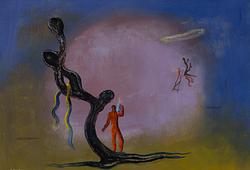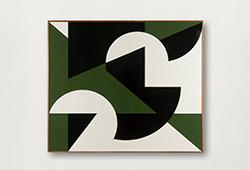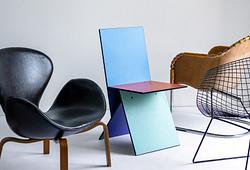Carl Bergsten
an important chair, Gemla Leksaksfabrik, Diö, for the Norrköping Exhibition of Art and Industry, 1906.
Blackened bent wood of birch on five ball feet, circular seat upholstered in green leather. Height 106 cm, seat height 46 cm.
Carefully restored.
Alkuperä - Provenienssi
Strömsholmen's restaurant, Norrköping.
The restaurant building was designed by architect Carl Bergsten for the Norrköping Exhibition of Art and Industry in 1906, and became a centre for Norrköping's nightlife until the building was destroyed in a large fire in June 1939.
After the exhibition in 1906, most of the buildings were demolished, but the hunting lodge designed by Bergsten from the exhibition was moved to an island in Bråviken just outside Norrköping. To this hunting lodge, eight of the few remaining chairs from Strömsholmen's restaurant were also brought. The set was sold at auction in 2000. The present chair is one of the eight chairs that were part of the set.
Kirjallisuus
Ivar Tengbom (ed.), "Arkitektur och dekorativ konst", No. 6, 1908, see image from the restaurant p. 69.
Monica Boman (ed.), "Svenska möbler 1890-1990", Signum 1993, p. 99.
Bonnie Festin, "Carl Bergsten - en arkitekt och hans former", Norrköpings Stadsmuseum 2005, p. 12, 31.
Muut tiedot
Designed for the café at Strömsholmen's restaurant, erected in connection with the Norrköping Exhibition of Art and Industry in 1906.
The significance of architect and furniture designer Carl Bergsten for the development of modern architecture and furniture design in Sweden during the early 20th century cannot be overstated. Several of his commissions, such as the Exhibition of Art and Industry in Norrköping in 1906, the Swedish pavilion at the World Exhibition in Paris in 1925, and the interior of the M/S Kungsholm in 1928, have had a decisive impact on the development of Swedish architecture and design. For the Exhibition of Art and Industry in his hometown of Norrköping in 1906, Bergsten, then 25 years old, was appointed chief architect. In the years prior, Bergsten had met architect Josef Hoffmann in Vienna during a study trip in Europe and was inspired by him, his work with the Wiener Werkstätte, and also by his colleagues active in the progressive Vienna Secession. Bergsten brought these impressions back to Sweden and in 1906 executed one of the largest modern manifestations in Swedish history. For the Strömsholmen restaurant, Bergsten designed, among other things, this chair, which with its strict geometric forms and technical innovations came to write Swedish design history. Most likely, the majority of the chairs were destroyed in the fire in 1939.
Bergsten's innovative design required a manufacturer, which Bergsten found with Gemla Leksaksfabrik in Diö. The then-new bentwood technique that had inspired him during his meeting with Josef Hoffmann in Vienna required an ambitious producer. Together with Gemla, they experimented with materials and techniques to produce the first bentwood furniture in Sweden.



























































































